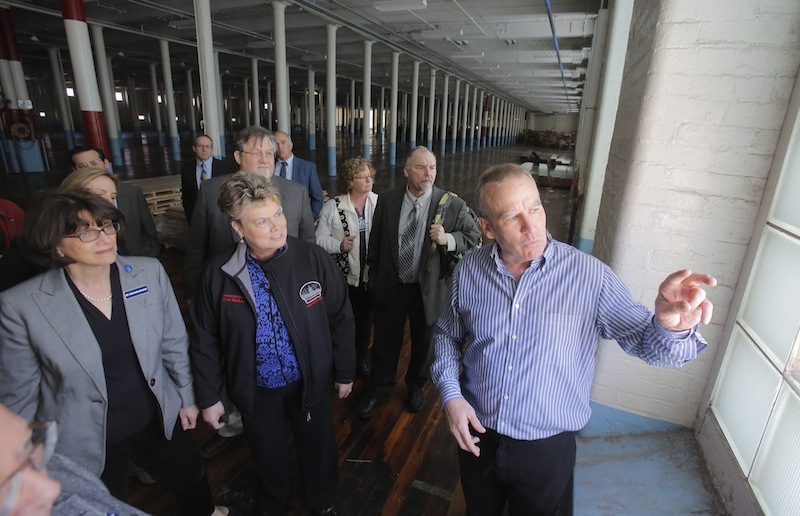The relatively high education level of Maine’s work force is expected to spur growth in the manufacturing sector, according to a national “report card” issued Tuesday on each state’s manufacturing-growth potential.
But the report card, from Indiana’s Ball State University, says the high cost of workers’ benefits, unfunded taxpayer liabilities and other problems could limit Maine’s growth potential.
The university’s 2013 Manufacturing and Logistics National Report examines several factors that could foster or inhibit manufacturing growth in each of the 50 states. The university’s Center for Business and Economic Research has been producing the report annually since 2008.
Overall, the report gave Maine a C to describe the health of its manufacturing industry.
The state’s highest grade came in the category of “human capital,” which assesses workers’ education and skill level. The state got a B in that area.
Michael Hicks, director of the Center for Business and Economic Research and the author of the report, said Maine ranks 13th in the nation for eighth-grade math scores, which are regarded as the bellwether for work-force quality in the manufacturing sector.
The state also scored above average for four-year college graduates per capita, he said.
That’s a significant advantage, Hicks said, because it likely would take decades of education reform for poor-performing states to catch up with Maine.
“If you could pick one score that would really matter to your future, it would be human capital,” he said.
Maine scored much lower in other areas, ranking near the bottom in areas such as workers’ benefits, Hicks said. For the high cost of benefits, the report gave Maine an F.
Hicks said the primary problem is that Maine’s health care costs per capita are the 10th-highest in the country.
That is likely to deter some manufacturers from opening or expanding operations in the state, he said.
To boost Maine’s potential for manufacturing growth, policy makers would have to examine why health care is so expensive and work to lower those costs, Hicks said.
Lisa Martin, executive director of the Manufacturers Association of Maine, agreed that high benefit costs are a significant problem for employers in the state.
Martin said heath care benefits can add as much as 50 percent to the total cost of an employee at the lower end of the wage scale.
Employers are aware of the problem and have been working to lower those costs, she said. But uncertainty about how the federal Affordable Care Act will affect businesses when it takes full effect Jan. 1 have put much of that work on hold.
“It’s a major issue,” Martin said.
Christopher Hall, CEO of the Portland Regional Chamber, said Maine’s reliance on manufacturing as a source of jobs has diminished since 1990, when the industry employed about 25 percent of the state’s work force. That number is down to about 10 percent, he said.
Hall said health-care costs per capita are generally higher in Maine than in other states because of Maine’s “poor, rural, old population” and its high rate of uncompensated care.
Another weak area for Maine is what the report calls the “expected liability gap,” which refers to unfunded state and local obligations such as employee pension plans. Maine got a D-minus in that category.
Hicks said Maine’s score would be relatively easy to improve, but it would require policy changes to reduce the burden on taxpayers, such as raising the retirement age for government employees by one year.
Unless state officials act to narrow the liability gap, it could lead to higher taxes. He said that could be a significant deterrent to manufacturing growth in Maine, where the current tax climate earned the state a D-plus on the report card.
“That’s a very acute problem,” Hicks said.
Gov. Paul LePage’s press secretary, Adrienne Bennett, did not respond to two phone messages and an email Tuesday seeking comment on the report.
Hall said not all recent studies agree on whether Maine’s tax environment is good or bad for employers. He noted that an Ernst & Young LLP study from December 2011 ranked Maine No. 1 among states in terms of imposing the lowest total tax burden on new investment and job creation.
“We’ve done quite a bit in the last 10 years to create a more favorable tax climate,” Hall said.
Martin said her organization has been keeping its eye on local, national and international manufacturing trends in an effort to improve Maine’s overall grade of C.
“Are we happy to be in the middle of the road?” she said. “No.”
J. Craig Anderson can be contacted at 791-6390 or at canderson@mainetoday.com
Twitter: @jcraiganderson
Send questions/comments to the editors.




Success. Please wait for the page to reload. If the page does not reload within 5 seconds, please refresh the page.
Enter your email and password to access comments.
Hi, to comment on stories you must . This profile is in addition to your subscription and website login.
Already have a commenting profile? .
Invalid username/password.
Please check your email to confirm and complete your registration.
Only subscribers are eligible to post comments. Please subscribe or login first for digital access. Here’s why.
Use the form below to reset your password. When you've submitted your account email, we will send an email with a reset code.